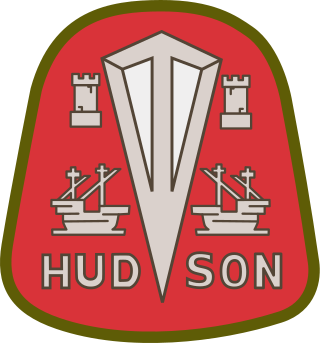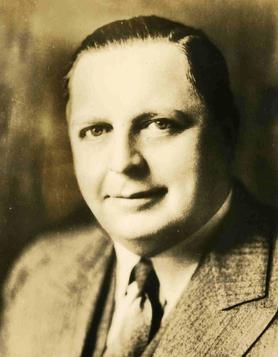
Lincoln Motor Company, or simply Lincoln, is the luxury vehicle division of American automobile manufacturer Ford. Marketed among the top luxury vehicle brands in the United States, Lincoln was positioned closely against its General Motors counterpart Cadillac. The division helped to establish the personal luxury car segment with the 1940 Lincoln Continental.

Packard or Packard Motor Car Company was an American luxury automobile company located in Detroit, Michigan. The first Packard automobiles were produced in 1899, and the last Packards were built in South Bend, Indiana in 1958.

Studebaker was an American wagon and automobile manufacturer based in South Bend, Indiana, with a building at 1600 Broadway, Times Square, Midtown Manhattan, New York City. Founded in 1852 and incorporated in 1868 as the Studebaker Brothers Manufacturing Company, the firm was originally a coachbuilder, manufacturing wagons, buggies, carriages and harnesses.

Charles Williams Nash was an American automobile entrepreneur who served as an executive in the automotive industry. He played a major role in building up General Motors as its 5th President. In 1916, he bought Thomas B. Jeffery Company, makers of the popular Rambler automobile, renamed it Nash Motors, and played an independent role in an automobile industry increasingly dominated by the Big Three: General Motors, Ford, and Chrysler. His profits came from focusing on one well-designed car in the upper-medium price range. He bought several distressed companies in Wisconsin, merging them and installing advanced managerial accounting procedures while cutting costs and focusing on long-term growth. He retired as president in 1932, but remained chairman of the board. His major acquisition was the merger in 1937 with the Kelvinator Company, which made refrigerators. During World War II, Nash-Kelvinator greatly expanded to manufacture aircraft engines and parts.

Nash Motors Company was an American automobile manufacturer based in Kenosha, Wisconsin from 1916 until 1937. From 1937 through 1954, Nash Motors was the automotive division of the Nash-Kelvinator Corporation. As sales of smaller firms declined after 1950 in the wake of the domestic Big Three automakers advantages in production, distribution, and revenue, Nash merged with Hudson Motors to form American Motors Corporation (AMC). Nash automobile production continued from 1954 through 1957 under AMC.

The Hudson Motor Car Company made Hudson and other branded automobiles in Detroit, Michigan, U.S., from 1909 until 1954. In 1954, Hudson merged with Nash-Kelvinator to form American Motors Corporation (AMC). The Hudson name was continued through the 1957 model year, after which it was discontinued.

William Crapo Durant was a leading pioneer of the United States automobile industry and co-founder of General Motors and Chevrolet. He created a system in which a company held multiple marques – each seemingly independent, with different automobile lines – bound under a unified corporate holding company. Durant, along with Frederic L. Smith, co-founded General Motors, as well as Chevrolet with Louis Chevrolet. He also founded Frigidaire.
Du Pont Motors was founded by E. Paul du Pont to produce marine engines for the Allied nations during World War I. After the war, Du Pont Motors produced extremely high-end automobiles. The cars were manufactured in Wilmington, Delaware.

Walter Emmett Flanders was an American industrialist in the machine tool and automotive industries and was an early mass production expert.

The Peerless Motor Car Company was an American automobile manufacturer that produced the Peerless brand of motorcars in Cleveland, Ohio, from 1900 to 1931. One of the "Three Ps" – Packard, Peerless, and Pierce-Arrow – the company was known for building high-quality luxury automobiles. Peerless popularized a number of vehicle innovations that later became standard equipment, including drum brakes and the first enclosed-body production cars.
The Studebaker-Packard Corporation was the entity created in 1954 by the purchase of the Studebaker Corporation of South Bend, Indiana, by the Packard Motor Car Company of Detroit, Michigan. While Studebaker was the larger of the two companies, Packard's balance sheet and executive team were stronger than that of the South Bend company.

The Packard Clipper is an automobile that was built by the Packard Motor Car Company for model years 1941–1942, 1946–1947 and 1953–1957. For 1956 only, Clipper was classified as a stand-alone marque. The Clipper was introduced in April 1941, as a mid-model year entry. It was available only as a four-door sedan. The Clipper name was re-introduced in 1953, for the automaker's lowest-priced lineup. By 1955, the Clipper models were seen as diluting Packard's marketing as a luxury automobile marque. It was named for a type of sailing ship, called a clipper.

The Packard 200 was an automobile model produced by the Packard Motor Car Company of Detroit, Michigan during model years 1951 and 1952. Models in the 200 designation represented the least expensive Packard model range, on the firm's shortest wheelbase, and least powerful 288 cu in (4.7 L) 8-cylinder in-line engine. It replaced the Packard One-Twenty and the Packard One-Ten, and was renamed the Packard Clipper for the 1953 model year.

George Walter Mason was an American industrialist. During his career Mason served as the Chairman and CEO of the Kelvinator Corporation (1928-1937), Chairman and CEO of the Nash-Kelvinator Corporation (1937-1954), and Chairman and CEO of American Motors Corporation (1954).

The Packard Custom Super Eight One-Eighty was introduced for the 1940 model year by the Packard Motor Car Company to replace the discontinued Packard Twelve as their top-of-the-line luxury model. The car was derived from the Packard Super Eight One-Sixty with which it shared the complete running gear including the in-line eight-cylinder, 356-cubic-inch (5,830 cc) engine that developed 160 horsepower. It was advertised as the most powerful eight-cylinder engine offered by any automobile manufacturer in 1940.. It was complemented and gradually replaced by the more modern looking and mid-level Packard Clipper in 1941 and integrated into the Super Eight after the war.

Richard Henry Arbib was an American industrial designer.

The automotive industry in the United States began in the 1890s and, as a result of the size of the domestic market and the use of mass production, rapidly evolved into the largest in the world. The United States was the first country in the world to have a mass market for vehicle production and sales and is a pioneer of the automotive industry and mass market production process. During the course of the 20th century global competitors emerged especially in the second half of the century primarily across European and Asian markets, such as Germany, France, Italy, Japan and South Korea. The U.S. is currently second among the largest manufacturer(s) in the world by volume.

The 1950s were pivotal for the American automobile industry. The post-World War II era brought a wide range of new technologies to the automobile consumer, and a host of problems for the independent automobile manufacturers. The industry was maturing in an era of rapid technological change; mass production and the benefits from economies of scale led to innovative designs and greater profits, but stiff competition between the automakers. By the end of the decade, the industry had reshaped itself into the Big Three, Studebaker, and AMC. The age of small independent automakers was nearly over, as most of them either consolidated or went out of business.
When Heaven was at the Corner of Sycamore and Main was an advertising slogan used by the Packard Motor Car Company to help promote their luxury automobile starting at the end of the 1930s.

Owen Ray Skelton was an American automotive industry engineer and automobile designer. Along with Fred M. Zeder and Carl Breer, he was one of the core group who formed the present day Chrysler Corporation. He made material contributions to Tourist Automobile Company, Allis-Chalmers, Studebaker, and was the main engineer behind the Chrysler Airflow automobile. He was elected to the Automotive Hall of Fame in 2002.



















